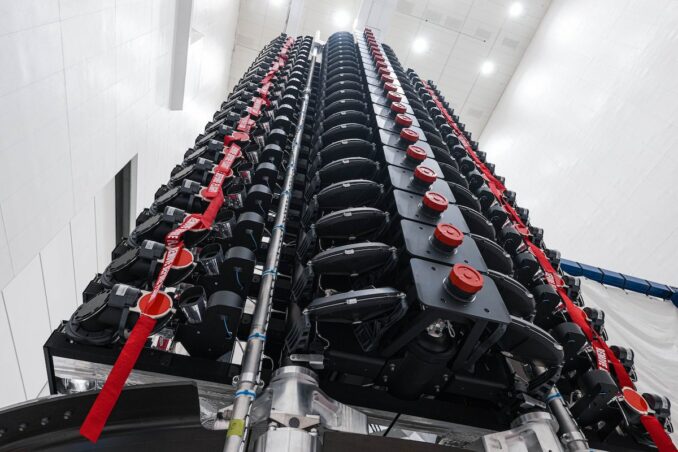
SpaceX will make another attempt Monday night to launch a Falcon 9 carrying 23 more satellites for its Starlink internet service from Cape Canaveral. Liftoff from pad 40 is scheduled for 7:20 p.m. EDT (2320 UTC).
On Sunday night the countdown reached T-30 seconds when an abort was called. The launch director said a problem was detected with the system used to separate the first and second stages of the rocket and launch was pushed back to Monday.
A forecast issued by the 45th Weather Squadron at Cape Canaveral gave the Falcon 9 an 95-percent chance of favorable conditions for launch. The only concern being rules associated with lightning-triggering cumulus clouds.
SpaceX has seven back up launch opportunities on Monday night if needed, the last of which is at 10:22 p.m. EDT (0222 UTC).
Spaceflight Now will bring you live coverage from the Cape, starting about an hour before launch.
[embedded content]
After lifting off from Space Launch Complex 40 (SLC-40) at Cape Canaveral Space Force Station, the Falcon 9 will pitch and roll onto a south-easterly trajectory as it targets an orbit inclined at 43 degrees to the equator.
The first-stage booster, making its eighth flight, will touch down on the drone ship ‘Of Course I Still Love you’ about eight and a half minutes after launch.
The booster, tail number B1077, first flew in October 2022, carrying Crew 5 to the International Space Station aboard Dragon Endurance. It went on to fly the GPS III F6, Inmarsat I6-F2, CRS-28, and Intelsat G-37 missions, plus two Starlink delivery flights.
Deployment of the 23 Starlink satellites into a 182×177 mile (293×285 km) orbit is scheduled to occur 1 hour, 5 minutes and 38 seconds after launch.
A launch of 22 Starlinks from Vandenberg Space Force Base in California on Sunday brought the number of Starlink satellites currently in orbit to 4,988, according to statistics compiled by Jonathan McDowell. If all goes according to plan with Monday’s East Coast launch, SpaceX will have more than 5,000 Starlink satellites in orbit.
Tonight’s launch will be the 90th orbital mission for SpaceX in the last 365 days, roughly a launch every four days on average. Company officials have said they hope to accelerate the pace of launches and make 100 flights in 2023, surging to a total of 144 in 2024.
- SEO Powered Content & PR Distribution. Get Amplified Today.
- PlatoData.Network Vertical Generative Ai. Empower Yourself. Access Here.
- PlatoAiStream. Web3 Intelligence. Knowledge Amplified. Access Here.
- PlatoESG. Carbon, CleanTech, Energy, Environment, Solar, Waste Management. Access Here.
- PlatoHealth. Biotech and Clinical Trials Intelligence. Access Here.
- Source: https://spaceflightnow.com/2023/10/30/live-coverage-spacex-to-launch-23-starlink-satellites-on-falcon-9-rocket-from-cape-canaveral/
- :has
- :is
- ][p
- $UP
- 000
- 1
- 10
- 100
- 20
- 2022
- 2023
- 2024
- 22
- 23
- 40
- 678
- 7
- 9
- a
- About
- accelerate
- According
- After
- All
- an
- and
- Another
- AS
- associated
- At
- attempt
- average
- back
- base
- BE
- before
- being
- booster
- bring
- brought
- by
- california
- called
- cape
- carrying
- Chance
- Coast
- company
- complex
- Concern
- conditions
- content
- countdown
- course
- coverage
- credit
- crew
- Currently
- Days
- delivery
- detected
- Director
- down
- Dragon
- drone
- Earlier
- East
- east coast
- Eighth
- embedded
- Every
- Facility
- falcon
- Falcon 9
- favorable
- First
- flight
- Flights
- For
- Force
- Forecast
- four
- from
- gave
- Goes
- gps
- Half
- Have
- High
- hope
- hour
- HTML
- http
- HTTPS
- i
- if
- iii
- in
- Inclined
- inside
- International
- international space station
- Internet
- into
- Issued
- IT
- ITS
- jonathan
- jpg
- Last
- launch
- launches
- lifting
- live
- love
- make
- Making
- max-width
- minutes
- Mission
- missions
- Monday
- more
- needed
- night
- now
- number
- occur
- october
- of
- off
- officials
- on
- only
- opportunities
- Orbit
- Pace
- pad
- photo
- Pitch
- plan
- plato
- Plato Data Intelligence
- PlatoData
- player
- plus
- Problem
- processing
- pushed
- reached
- rocket
- Roll
- roughly
- rules
- Said
- satellites
- scheduled
- Second
- seconds
- separate
- service
- seven
- Space
- Space Force
- space station
- SpaceX
- stages
- starlink
- Starting
- station
- Still
- sunday
- surging
- system
- targets
- than
- The
- they
- this
- this year
- to
- Total
- touch
- trajectory
- two
- used
- UTC
- Video
- was
- Weather
- went
- when
- which
- will
- with
- year
- you
- youtube
- zephyrnet








